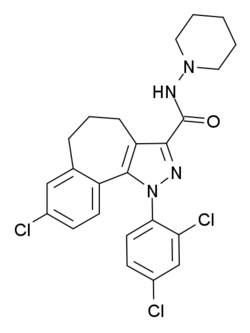Chemistry:NESS-0327
From HandWiki
Short description: Chemical compound
 | |
| Identifiers | |
|---|---|
| CAS Number | |
| PubChem CID | |
| ChemSpider | |
| UNII | |
| Chemical and physical data | |
| Formula | C24H23Cl3N4O |
| Molar mass | 489.83 g·mol−1 |
| 3D model (JSmol) | |
| |
| |
| | |
NESS-0327 is a drug used in scientific research which acts as an extremely potent and selective antagonist of the cannabinoid receptor CB1. It is much more potent an antagonist, and more selective for the CB1 receptor over CB2, than the more commonly used ligand rimonabant, with a Ki at CB1 of 350fM (i.e. 0.00035nM) and a selectivity of over 60,000x for CB1 over CB2.[1] Independently, two other groups have described only modest nanomolar CB1 affinity for this compound (125nM[2] and 18.4nM[3]). Also unlike rimonabant, NESS-0327 does not appear to act as an inverse agonist at higher doses, instead being a purely neutral antagonist which blocks the CB1 receptor but does not produce any physiological effect of its own.[4]
See also
- Discovery and development of Cannabinoid Receptor 1 Antagonists
- NESS-040C5
References
- ↑ "Synthesis and characterization of NESS 0327: a novel putative antagonist of the CB1 cannabinoid receptor". The Journal of Pharmacology and Experimental Therapeutics 306 (1): 363–70. July 2003. doi:10.1124/jpet.103.049924. PMID 12663689.
- ↑ "Design, synthesis and biological activity of rigid cannabinoid CB1 receptor antagonists". Chemical & Pharmaceutical Bulletin 50 (8): 1109–13. August 2002. doi:10.1248/cpb.50.1109. PMID 12192147.
- ↑ "Conformationally constrained analogues of N-(piperidinyl)-5-(4-chlorophenyl)-1-(2,4- dichlorophenyl)-4-methyl-1H-pyrazole-3-carboxamide (SR141716): design, synthesis, computational analysis, and biological evaluations". Journal of Medicinal Chemistry 51 (12): 3526–39. June 2008. doi:10.1021/jm8000778. PMID 18512901.
- ↑ "Modulation of ATP-mediated contractions of the rat vas deferens through presynaptic cannabinoid receptors". European Journal of Pharmacology 525 (1–3): 150–3. November 2005. doi:10.1016/j.ejphar.2005.09.058. PMID 16271359.
 |

